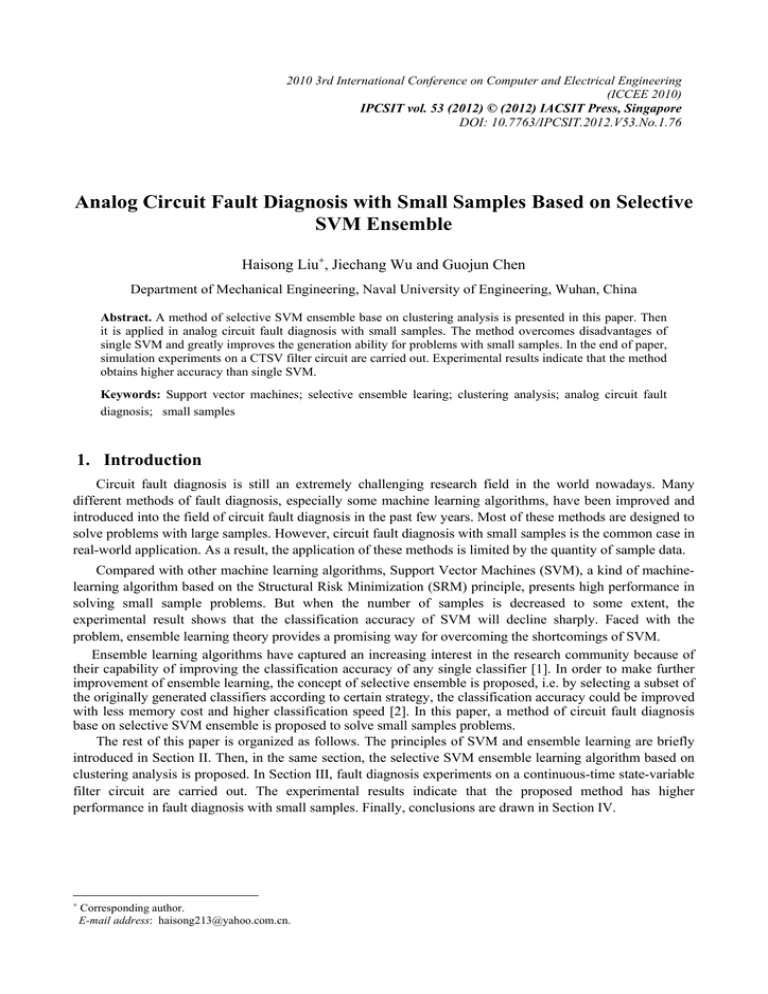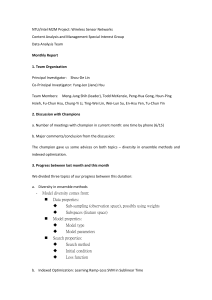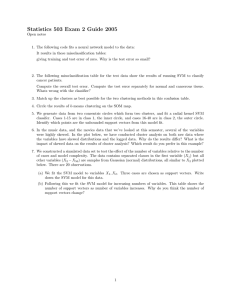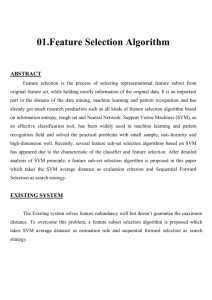Document 13136196
advertisement

2010 3rd International Conference on Computer and Electrical Engineering
(ICCEE 2010)
IPCSIT vol. 53 (2012) © (2012) IACSIT Press, Singapore
DOI: 10.7763/IPCSIT.2012.V53.No.1.76
Analog Circuit Fault Diagnosis with Small Samples Based on Selective
SVM Ensemble
Haisong Liu+, Jiechang Wu and Guojun Chen
Department of Mechanical Engineering, Naval University of Engineering, Wuhan, China
Abstract. A method of selective SVM ensemble base on clustering analysis is presented in this paper. Then
it is applied in analog circuit fault diagnosis with small samples. The method overcomes disadvantages of
single SVM and greatly improves the generation ability for problems with small samples. In the end of paper,
simulation experiments on a CTSV filter circuit are carried out. Experimental results indicate that the method
obtains higher accuracy than single SVM.
Keywords: Support vector machines; selective ensemble learing; clustering analysis; analog circuit fault
diagnosis; small samples
1. Introduction
Circuit fault diagnosis is still an extremely challenging research field in the world nowadays. Many
different methods of fault diagnosis, especially some machine learning algorithms, have been improved and
introduced into the field of circuit fault diagnosis in the past few years. Most of these methods are designed to
solve problems with large samples. However, circuit fault diagnosis with small samples is the common case in
real-world application. As a result, the application of these methods is limited by the quantity of sample data.
Compared with other machine learning algorithms, Support Vector Machines (SVM), a kind of machinelearning algorithm based on the Structural Risk Minimization (SRM) principle, presents high performance in
solving small sample problems. But when the number of samples is decreased to some extent, the
experimental result shows that the classification accuracy of SVM will decline sharply. Faced with the
problem, ensemble learning theory provides a promising way for overcoming the shortcomings of SVM.
Ensemble learning algorithms have captured an increasing interest in the research community because of
their capability of improving the classification accuracy of any single classifier [1]. In order to make further
improvement of ensemble learning, the concept of selective ensemble is proposed, i.e. by selecting a subset of
the originally generated classifiers according to certain strategy, the classification accuracy could be improved
with less memory cost and higher classification speed [2]. In this paper, a method of circuit fault diagnosis
base on selective SVM ensemble is proposed to solve small samples problems.
The rest of this paper is organized as follows. The principles of SVM and ensemble learning are briefly
introduced in Section II. Then, in the same section, the selective SVM ensemble learning algorithm based on
clustering analysis is proposed. In Section III, fault diagnosis experiments on a continuous-time state-variable
filter circuit are carried out. The experimental results indicate that the proposed method has higher
performance in fault diagnosis with small samples. Finally, conclusions are drawn in Section IV.
+
Corresponding author.
E-mail address: haisong213@yahoo.com.cn.
2. Selective Svm Esemble Algorithm
2.1 Principle of support vector machines
In this paper, we merely take the nonlinear two-class classification problem as an example to analyze the
principle of SVM briefly. Given a set of training vectors belonging to two classes
T = {( x1 , y1 ),
, ( xl , yl )} ,
xi ∈ R , yi ∈ {1,−1}, i = 1,
n
,l .
(1)
The training vectors are mapped into a high dimensional feature space to solve the nonlinear problem.
Then we seek a linear separating hyperplane, called optimal separating hyperplane, with the maximal margin
in this high dimensional feature space.
The problem mentioned above leads to the following optimization problem,
l
1 2
ω + C ∑ ξi ,
ω ,b ,ξ
2
i =1
s.t. yi ((ω ⋅ φ (xi )) + b ) ≥ 1 − ξ i , i = 1, … , l ,
min
(2)
where C > 0 is the penalty parameter of the error term, and ξBi B≥ 0 is the slack variable. The primal
problem can be transformed to its dual problem, which is easier to solve. The dual problem is given by,
l
1 l l
(
)
y
y
α
α
K
x
,
x
−
αi ,
∑∑ i j i j i j ∑
2 i =1 j =1
i =1
min
α
l
s.t.
∑ yα
i =1
i
i
= 0, α i ≥ 0, i = 1,
,l ,
(3)
where α is the Lagrange multiplier. After solving the dual problem, the decision function is given by,
(
)
⎡ l
⎤
f ( x ) = sgn ⎢∑ α i* yi K ( xi , x ) + b* ⎥ .
⎣ i=1
⎦
(4)
Here, K xi , x j is the kernel function. Generally, there are four common kernel functions as follows:
linear, polynomial, radial basis function (RBF), sigmoid. And RBF kernel is usually a reasonable first choice
among these kernel functions [3]. RBF kernel is defined as
(
)
K ( x, xi ) = exp − x − xi / 2σ 2 .
2
(5)
SVM was originally designed for binary classification. In order to solve the multi-class problem, the
typical method is to construct a multi-class classifier by combining several binary classifiers. There are three
main methods based on binary classifiers: “one-against-all”, “one-against-one” and DAGSVM [4].
2.2 Ensemble learning theory
Ensemble learning has gradually become the most popular research direction in machine learning since
the mid-1990s. An ensemble of classifiers is constituted by a set of predictors that, instead of yielding their
individual decisions to classify new examples, combine them together by adopting some strategy. High
diversity and relatively high accuracy of member classifiers are two essential conditions for the improvement
of ensemble accuracy. Bagging [5] and Boosting [6] are two most representative algorithms of ensemble
learning. In Bagging, classifiers are trained independently via a bootstrap method, while in Boosting the
selection of training samples depends on the effect of last learning.
Selective ensemble theory is a new ensemble learning paradigm proposed by Zhou and its main idea is
many could be better than all [7]. Compared with Bagging and Boosting, selective ensemble can generate
classifier ensembles with far smaller sizes but stronger generalization ability. Meanwhile, Zhou proposed a
genetic algorithm based approach named GASEN (Genetic Algorithm based Selective ENsemble), which
trains a number of individual neural networks and then employs a genetic algorithm to select an optimum
subset of individual networks to constitute an ensemble [8]. In order to improve the diversity of individuals in
neural networks ensemble, clustering algorithm based selective ensemble (CLUSEN) is proposed by Li and
Yang [9], which substitutes clustering algorithm for genetic algorithm. The experimental results on UCI data
sets show that CLUSEN is more efficient than GASEN. Inspired by Li’s work, clustering algorithm based
selective ensemble is applied in SVM in this paper.
2.3 Selective SVM ensemble based on clustering algorithm
The selective SVM ensemble learning algorithm in this paper employs bootstrap sampling to generate T
different training sets from the original training set for training T SVM classifiers. Then these SVM classifiers
are partitioned into K clusters by the use of K-means clustering analysis, which could improve the diversity of
sub-classifiers. And the classifier which is nearest to clustering centroid in every part is chosen to compose
selected SVM classifiers set. Finally, the ensemble SVM model is obtained by plurality voting. The algorithm
is shown in Fig.1.
Input: training set S, number of bootstrap samples T, number of
clusters K
Output: ensemble NP*P
1. for i = 1 : T
SBi =
B bootstrap sample from training set S
NBi B= SVM model trained by bootstrap sample SBi
FBi B= classification accuracy of SVM model NBiB on set S
end
2. generate K clusters from N by using clustering analysis
3. for i = 1 : K
for j = 1 : T
DBiB(j) = distance from each point to every centroid
MBiB= SVM model with the maximum element in set DBiB
end
end
4. for i = 1 : K
RBiB = classification result of SVM model MBiB on testing sample
set
end
NP* P= ensemble SVM model by using plurality voting on set R
Figure 1.
Selective SVM Ensemble based on Clustering Algorithm.
3. Simulation Experiment and Result Analysis
3.1 The circuit under test (CUT) and parameters settings
A Continuous-Time State-Variable (CTSV) filter circuit [10] chosen from ITC’97 benchmark circuits is
shown in Fig.2. And this circuit serves as experimental circuit in this paper. The tolerance of resistors and
capacitors is 10% in the circuit.
R5
10k
R2
10k
Vss
10k
-5V
+
U1
0
R7
R6
3k
7k
0
-5V
+5V
R4
OUT
BPO
10k
+
U3
Vss
AC = 1
PW = 10u U2
PER = 12u
R3
OUT
HPO
20n
Vdd
+
+5V
Vdd
10k
V4
C2
26n
Vss
-
Vdd
Vin
C1
+5V
R1
OUT
LPO
Vout
-5V
0
0
Figure 2.
Continuous-Time State-Variable Filter Circuit
Fault models for analog circuits can be classified into two categories: hard faults and soft faults. Hard
faults mainly consist of stuck-open fault and stuck-short fault. Soft faults are deviations of component
parameters which are out of specified tolerance limits, as shown in Table 1. Compared with hard faults, soft
faults are more difficult to diagnose. Thus nine different soft faults, including single fault and multiple faults
modes, are chosen randomly for simulation experiments. The nine soft faults are shown in Table 2.
Table 1 Single Soft Faults of the Circuit
Fault Class
Normal
Value
Fault Value
R1~R5↑
10kΩ
11.8kΩ
R1~R5↓
10kΩ
8.2kΩ
R6↑
3kΩ
3.54 kΩ
R6↓
3kΩ
2.46 kΩ
R7↑
7kΩ
8.26kΩ
R7↓
7kΩ
5.74kΩ
C1↑
20nF
26.0nF
C1↓
20nF
14.0nF
C2↑
20nF
23.6nF
C2↓
20nF
16.4nF
We generate the training and testing data in our experiments by the use of OrCAD/Pspice 10.5. For all the
SPICE simulation, we input a single impulse of height 5V and duration 10 µs into the filter. To obtain
multiple data within tolerance of 10%, 1000 Monte-Carlo analyses of each fault class are performed. The fault
samples are extracted from output frequency response curve. We extract 10 points with equal space from
output curve. Thus every sample date consists of 10 voltage values. Then fault samples data are scaled to the
range [0, 1]. For each fault class (including no-fault class), we divide the 1000 samples into two parts: first 5
samples used for training; the other 995 samples used for testing. Finally, the training set has 50 samples and
testing set has 9950 samples.
In the experiments, we choose the RBF kernel for SVM. Meanwhile, considering the characteristics of
analog circuit testing, we use one-against-one method due to its high accuracy for classification. The related
parameters contain the penalty parameter C and kernel parameter σ. And the parameters (C, σ) are set at
(10000, 7) which could obtain relatively high classification accuracy in most cases. Other parameters are
setting as follows: number of bootstrap samples T = 100, number of clusters K = 15.
3.2 Experiment Results and Analysis
The average accuracy of selective SVM ensemble in testing experiment is 70.41%. Meanwhile, we test
the same samples by using single SVM. The parameters of SVM are set by k-fold cross-validation method.
Then the single SVM obtains the average accuracy of 57.43%. Table II shows the results of two fault
diagnosis methods. From the data in table II, it is clear that the accuracy of our algorithm is higher in all kinds
of fault modes.
In addition, experiments of the two methods with different number of training samples are carried out.
The numbers are, respectively, set to 100, 200, 300, and 400. The experimental results, shown in Fig.3,
indicate that the gap between the results of selective SVM ensemble and single SVM is gradually reduced
along with the increase of sample number. When the number of samples is 400, single SVM obtains higher
accuracy than selective SVM ensemble.
Table 2 Comparison of results of two fault diagnosis methods with 50 training samples
Selective
Fault ID
Fault Class
SVM
Ensemble (%)
Single
SVM (%)
F0
No-fault
76.78
41.3
F1
R2↑
51.53
11.05
F2
R3↓
67.93
47.93
F3
R3↑& R5↑
97.58
90.15
F4
R4↓& R5↓
64.3
27.73
F5
C1↑
70.95
88.04
F6
C1↑& C2↓
50.55
70.45
F7
R4↑& C1↓
39.65
34.67
F8
R1↓& C2↑
85.2
64.42
F9
R1↓& R5↑
99.69
98.59
Selective SVM Ensemble
Single SVM
100
90
accuracy (%)
80
70
60
50
40
30
20
10
0
50
100
200
300
400
number of training samples
Figure 3.
Accuracies Obtained by Two Fault Diagnosis Methods with Different Number of Training Samples
4. Conclusion
In this paper, selective SVM ensemble base on clustering analysis is applied to solve small samples
problems. It overcomes disadvantages of single SVM for problems with small samples. Experimental results
indicate that the method obtains higher accuracy than single SVM. Meanwhile, another set of experiments are
carried out by changing the number of training samples. And the results show that the proposed method
merely presents good performance in solving sample problems.
5. References
[1] G. Folino, C. Pizzuti, and G. Spezzano, “Training distributed GP ensemble with a selective algorithm based on
clustering and pruning for pattern classification,” IEEE Transactions on Evolutionary Computation, vol. 12, 2008,
pp. 458-468.
[2] Hongda Zhang, Xiaodan Wang, Chongming Wu, Bo Ji, and Hailong Xu, “Selective SVM ensembles based on
modified BPSO,” Proc. 2008 IEEE Pacific-Asia Workshop on Computational Intelligence and Industrial
Application (PACIIA 2008), IEEE Press, Dec. 2008, pp. 243-246.
[3] Hsuan-Tien Lin and Chih-Jen Lin, “A study on sigmoid kernels for SVM and the training of non-PSD kernels by
SMO-type methods,” Report, National Taiwan University, 2003.
[4] Chih-Wei Hsu and Chih-Jen Lin, “A comparison of methods for multi-class support vector machines,” IEEE
Transactions on Neural Networks, vol. 13, Feb. 2002, pp. 415-425.
[5] Breiman Leo, “Bagging predictors,” Machine learning, vol. 24, Aug. 1996, pp. 123-140.
[6] Freund Y., “Boosting a weak algorithm by majority,” Proceedings of the Third Annual Workshop on
Computational Learning Theory, vol. 121, Aug. 1990, pp. 212-216.
[7] Zhihua Zhou, Jianxin Wu, and Wei Tang, “Ensembling neural networks: many could be better than all,” Artificial
Intelligence, vol. 137, May. 2002, pp. 239-263.
[8] Zhihua Zhou, Jianxin Wu, Wei Tang, and Zhaoqian Chen, “Combining regression estimators: GA-based selective
neural network ensemble,” International Journal of Computational Intelligence and Applications, vol 1, Dec. 2001,
pp. 341-356.
[9] Guozheng Li, Jie Yang, Ansheng Kong, and Nianyi Chen, “Clustering algorithm based selective ensemble,”
Journal of Fudan University (Natural Science), vol. 43, Oct. 2004, pp. 689-691.
[10] B. Kaminska, K. Arabi, I. Bell, P. Goteti, and J.L. Heurtas, "Analog and Mixed-Signal Benchmark Circuits - First
Release", Proc. IEEE International Test Conference, IEEE Press, Nov. 1997, pp. 183-190.








